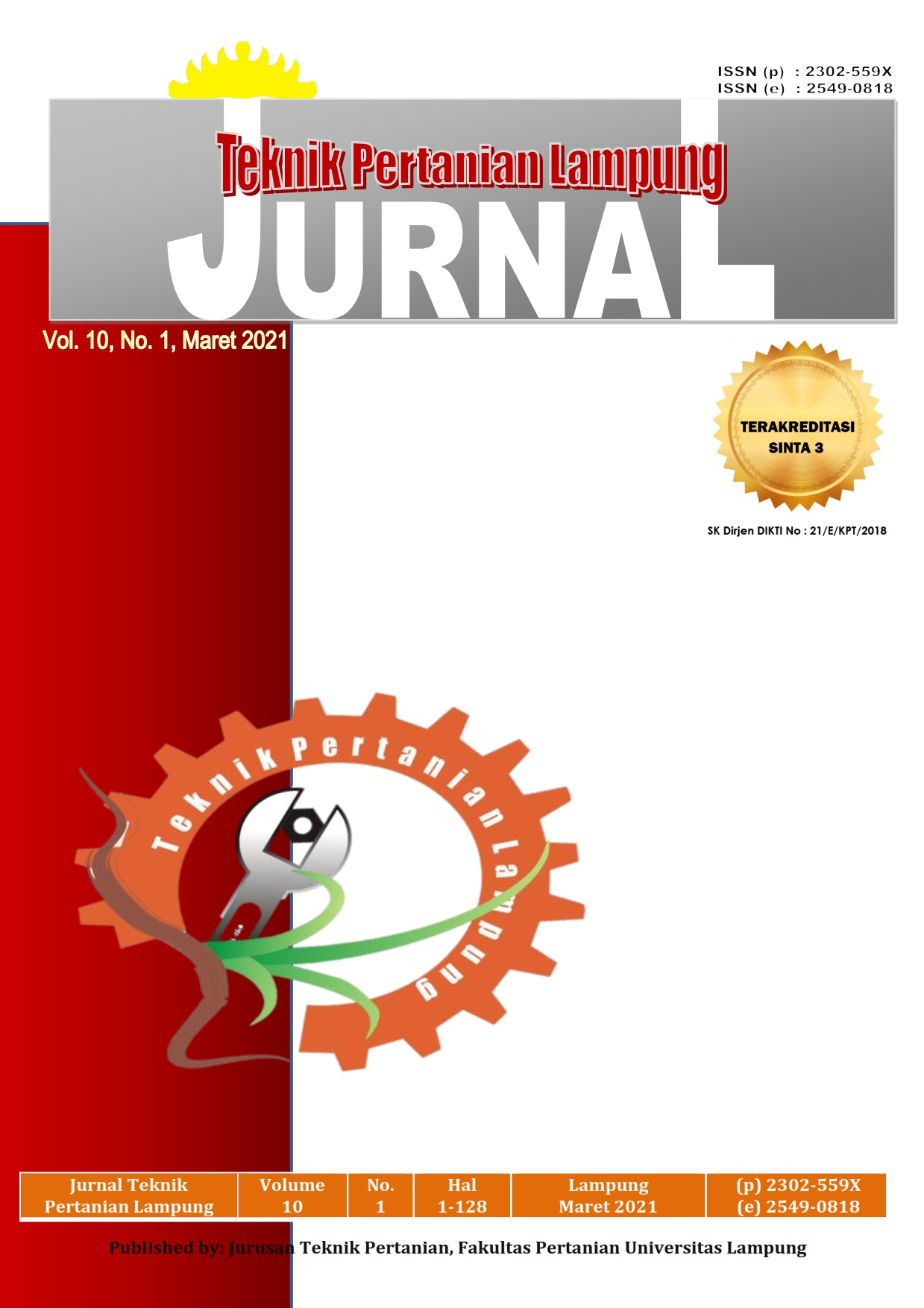PENGARUH UMUR DAUN TEH DAN WAKTU OKSIDASI ENZIMATIS TERHADAP KANDUNGAN TOTAL FLAVONOID PADA TEH HITAM (Camellia sinesis)
DOI:
https://doi.org/10.23960/jtep-l.v10i1.41-48Abstract
Flavonoid compound is an important compound of tea products. However, the flavonoid level content in black tea is lowest than other teas. This is due to the processing of black tea which has an enzymatic oxidation stage and the tea age leaves when picking. Young tea leaves contain higher total flavonoids than old tea leaves. With an average level of total flavonoids, the young tea leaves is 27.76% qe w / w, while for the old tea leaves 18.61% qe w / w. However, the enzymatic oxidation time treatment did not affect the total flavonoids because the process only affected the quality of black tea steeping, on its colour, aroma, and taste.
Keywords: age of tea leaves, black tea, enzymatic oxidation, total flavonoids
References
Angraiyati, D dan Faizah, H. 2017. Lama Pengeringan Pada Pembuatan Teh Herbal Daun Pandan Wangi (Pandanus Amarylifolius Roxb.,) Terhadap Aktivitas Antioksidan. JOM Faperta UR. 4(1): 1-12.
Asil, M.H., Babak, R., Reza, H. A. 2012. Optimal Fermentation Time and Temperature to Improve Biochemical Composition and Sensory Characteristics Of Black Tea. Australian Journal of Crop Science. 6(3): 550-558
Biju, J. Sulaiman, C. T. Satheesh, G and V R K Reddy. 2014. Total Phenolics and Flavonoids in Selected Medicinal Plants From Kerala. International Journal of Pharmacy and Pharmaceutical Sciences. 6(1): 406-408.
Chan, E. W. C., Y. Y. Lim., Y. L. Chew. 2007. Antioxidant Activity of Camellia Sinensis Leaves and Tea from a Lowland Plantation In Malaysia.Journal Food Chemistry.102: 1214-1222.
Emdadi, L., B. Nasernajad., S.T. Shokrgozar., M. Mehranian and F. Vahazadeh. 2009. Optimization of Withering Time and Fermentation Conditions During the Manufacture of Black Tea Using a Response Surface Methodology.Chemistry and Chemical Engineering. 16(1): 61-68.
Grotewold, E. 2006. The Science of Flavonoid. United States of America: Springer.
Izzreen, N., Q and Mohd, F., A., B. 2013. Phytochemicals and Antioxidant Properties of Different Parts of Camellia Sinensis Leaves From Sabah Tea Plantation In Sabah, Malaysia. International Food Research Journal. 20(1): 307-312.
Lin, Y., Juan, I., Chen, Y., Liang, Y., Lin, J.1996. Composition of Polyphenols In Fresh Tea Leaves and Associations of Their Oxygen-Radical-Absorbing Capacity With Antiproliferative Actions In Fibroblast Cells.J. Agric. Food Chem. 44: 1387-1394.
Obanda, et. al. 2001. Changes In The Chemical and Sensory Quality Parameters of Black Tea Due to Variations of Fermentation Time and Temperature.Food Chemistry. 75: 395-404.
PPTK Gambung. 2006 dalam Anjasari. 2016. Katekin Teh Indonesia: Prospek dan Manfaatnya. Jurnal Kultivasi. 15(2): 99-106.
Riyanto, Ph. D. 2014. Validasi & Verifikasi Metoda Uji. Sesuai dengan ISO/IEC 17025. Laboratorium Pengujian dan Kalibrasi[Edisi 1 Cetakan 1].2014. Yogyakarta: Deepublish.
Rohdiana, D. 1999. Evaluasi Kandungan Theaglavin dan Thearubigin Pada Teh Kering Dalam Kemasan. JKTI. 9(1-2): 29-32.
Saslowsky, David and Brenda Winkel-Shirley. 2001. Localization of Flavonoid Enzymes in Arabidopsis Roots. The Plant Journal. 27(1): 37-48.
Sato, D., Namiko, I., and Tomomi, K. 2007. Home-Processing Black Tea and Green Tea (Camellia sinensis). Food Safety and Technology FST-26. Japan.
Snyder, F.W. and Carlson, G.E. 1983. Selecting for Partitioning of Photosynthetic Products In Crops. Advances in Agronomy. 37: 47 – 69.
Taiz, L and Zeiger, E. 2015. Plant Physiology 6 th Ed. Massachusetts: Sinauer Associates.
Towaha, J. 2013. Kandungan Senyawa Kimia Pada Daun Teh (Camellia sinensis). Warta Penelitian dan Pengembangan Tanaman Industri. 19(3): 12-16.
Turkmen, N., Ferda, S., Y. Sedat. V. 2009. Factor Affecting Polyphenol Contet and Composition on Fresh and Processed Tea Leaves. Review Paper Akademik Gida. 7(6): 29-40.
Wang, Qinghu., Jinmei, J., Nayintai, D., Narenchaoketu, H., Jingjing, H., Baiyinmuqier, B. 2016. AntiInflammatory Effects, Nuclear Magnetic Resonance Identiï¬cation and High Performance Liquid Chromatography Isolation of The Total Flavonoids From Artemisia Frigida. Journal Of Food and Drug Analysis. 24: 385-391.
Werkhoven, J. 1974. Tea Processing. Amsterdam: Royal Tropical Institute.
Wink, M. 1999. Biochemistry of Plant Secondary Metabolism. Annual Plant Reviews [Vol 2] Sheffield: Sheffield Academic Press.
Downloads
Published
Issue
Section
License
- Authors who publish with this journal agree to the following terms:
- Authors retain copyright and grant the journal right of first publication with the work simultaneously licensed under a Creative Commons Attribution-ShareAlike 4.0 International Lice that allows others to share the work with an acknowledgement of the work's authorship and initial publication in this journal.
- Authors are able to enter into separate, additional contractual arrangements for the non-exclusive distribution of the journal's published version of the work (e.g., post it to an institutional repository or publish it in a book), with an acknowledgement of its initial publication in this journal.
- Authors are permitted and encouraged to post their work online (e.g., in institutional repositories or on their website) prior to and during the submission process, as it can lead to productive exchanges, as well as earlier and greater citation of published work (See The Effect of Open Access).
Jurnal Teknik Pertanian Lampung

JTEPL is licensed under a Creative Commons Attribution-ShareAlike 4.0 International License.

